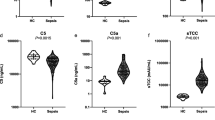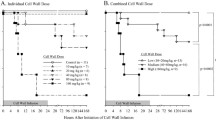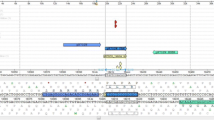Translocation of intestinal bacteria to ascitic fluid is, probably, the first step in the development of spontaneous bacterial peritonitis in patients with cirrhosis. Proteins of the complement system are soluble mediators implicated in the host immune response to bacterial infections and its activation has been traditionally considered to be an endotoxin-induced phenomenon. The aim of this study was to compare the modulation of these proteins in response to the presence of bacterial DNA and/or endotoxin in patients with advanced cirrhosis and ascites in different clinical conditions. Groups I and II consisted of patients without/with bacterial DNA. Group III included patients with spontaneous bacterial peritonitis and Group IV with patients receiving norfloxacin as secondary long-term prophylaxis of spontaneous bacterial peritonitis. Serum and ascitic fluid levels of endotoxin and truncated residues of the complement system were measured by ELISA. The complement system is triggered in response to bacterial DNA, as evidenced by significantly increased levels of C3b, membrane attack complex, and C5a in patients from Groups II and III compared with patients without bacterial DNA (Group I) and those receiving norfloxacin (Group IV). Gram classification did not further differentiate the immune response between patients within groups II and III, even though endotoxin levels were, as expected, significantly higher in patients with bacterial DNA from gram-negative microorganisms. The complement protein activation observed in patients with bacterial DNA in blood and ascitic fluid is indistinguishable from that observed in patients with spontaneous bacterial peritonitis and may occur in an endotoxin-independent manner.

Similar content being viewed by others
Abbreviations
- BT:
-
bacterial translocation
- AF:
-
ascitic fluid
- SBP:
-
spontaneous bacterial peritonitis
- SID:
-
selective intestinal decontamination
- bactDNA:
-
bacterial DNA
REFERENCE
Guarner C, Soriano G: Spontaneous bacterial peritonitis. Semin Liver Dis 17:203–217, 1997
Such J, Runyon BA: Spontaneous bacterial peritonitis. Clin Infect Dis 27:669–674, 1998
Garcia-Tsao G: Bacterial translocation: Cause or consequence of decompensation in cirrhosis? J Hepatol 34:150–155, 2001
Wiest R, Garcia-Tsao G: Bacterial translocation (BT) in cirrhosis. Hepatology 41:422–433, 2005
Berg RD: Bacterial translocation from the intestines. Jikken Dobutsu 34:1–16, 1985
Cirera I, Bauer TM, Navasa M, Vila J, Grande L, Taura P et al.: Bacterial translocation of enteric organisms in patients with cirrhosis. J Hepatol 34:32–37, 2001
Guarner C, Runyon BA, Young S, Heck M, Sheikh MY: Intestinal bacterial overgrowth and bacterial translocation in cirrhotic rats with ascites. J Hepatol 26:1372–1378, 1997
Llovet JM, Bartoli R, March F, Planas R, Viñado B, Cabre E et al.: Translocated intestinal bacteria cause spontaneous bacterial peritonitis in cirrhotic rats: Molecular epidemiologic evidence. J Hepatol 28:307–313, 1998
Fromkes JJ, Thomas FB, Mekhjian HS, Evans M: Antimicrobial activity of human ascitic fluid. Gastroenterology 73:668–672, 1977
Michel J, Bercovici B, Sacks T: Comparative studies on the antimicrobial activity of peritoneal and ascitic fluids in human beings. Surg Gynecol Obstet 151:55–57, 1980
Akalin HE, Laleli Y, Telatar H: Bactericidal and opsonic activity of ascitic fluid from cirrhotic and noncirrhotic patients. J Infect Dis 147:1011–1017, 1983
Runyon BA: Patients with deficient ascitic fluid opsonic activity are predisposed to spontaneous bacterial peritonitis. Hepatology 8:632–635, 1988
Runyon BA: Low-protein-concentration ascitic fluid is predisposed to spontaneous bacterial peritonitis. Gastroenterology 91:1343–1346, 1986
Such J, Guarner C, Enriquez J, Rodriguez JL, Seres I, Vilardell F: Low C3 in cirrhotic ascites predisposes to spontaneous bacterial peritonitis. J Hepatol 6:80–84, 1988
Guarner C, Gonzalez-Navajas JM, Sanchez E, Soriando G, Frances R, Chiva M et al.: The detection of bacterial DNA in blood of rats with CCl(4)-induced cirrhosis with ascites represents episodes of bacterial translocation. Hepatology 44:633–639, 2006
Chace JH, Hooker NA, Mildenstein KL, Krieg AM, Cowdery JS: Bacterial DNA-induced NK cell IFN-gamma production is dependent on macrophage secretion of IL-12. Clin Immunol Immunopathol 84:185–193, 1997
Klinman DM, Yi AK, Beaucage SL, Conover J, Krieg AM: CpG motifs present in bacteria DNA rapidly induce lymphocytes to secrete interleukin 6, interleukin 12, and interferon gamma. Proc Natl Acad Sci USA 93:2879–2883, 1996
Krieg AM, Yi AK, Matson S, Waldschmidt TJ, Bishop GA, Teasdale R et al.: CpG motifs in bacterial DNA trigger direct B-cell activation. Nature 374:546–549, 1995
Navasa M, Follo A, Filella X, Jimenez W, Francitorra A, Planas R et al.: Tumor necrosis factor and interleukin-6 in spontaneous bacterial peritonitis in cirrhosis: Relationship with the development of renal impairment and mortality. Hepatology 27:1227–1232, 1998
Runyon BA: Paracentesis of ascitic fluid. A safe procedure. Arch Intern Med 146:2259–2261, 1986
Runyon BA, Canawati HN, Akriviadis EA: Optimization of ascitic fluid culture technique. Gastroenterology 95:1351–1355, 1988
Such J, Frances R, Munoz C, Zapater P, Casellas JA, Cifuentes A et al.: Detection and identification of bacterial DNA in patients with cirrhosis and culture-negative, nonneutrocytic ascites. Hepatology 36:135–141, 2002
Frances R, Munoz C, Zapater P, Uceda F, Gascon I, Pascual S et al: Bacterial DNA activates cell mediated immune response and nitric oxide overproduction in peritoneal macrophages from patients with cirrhosis and ascites. Gut 53:860–864, 2004
Bercovici B, Michel J, Miller J, Sacks TG: Antimicrobial activity of human peritoneal fluid. Surg Gynecol Obstet 141:885–887, 1975
Soriano G, Coll P, Guarner C, Such J, Sanchez F, Prats G et al.: Escherichia coli capsular polysaccharide and spontaneous bacterial peritonitis in cirrhosis. Hepatology 21:668–673, 1995
Stevens P, Young LS, Adamu S: Opsonization of various capsular (K) E. coli by the alternative complement pathway. Immunology 50:497–502, 1983
Andreu M, Sola R, Sitges Serra A, Alia C, Gallen M, Vila MC et al.: Risk factors for spontaneous bacterial peritonitis in cirrhotic patients with ascites. Gastroenterology 104:1133–1138, 1993
Such J, Guarner C, Soriano G, Teixido M, Barrios J, Tena F et al.: Selective intestinal decontamination increases serum and ascitic fluid C3 levels in cirrhosis. Hepatology 12:1175–1178, 1990
Fernandez J, Navasa M, Gomez J, Colmenero J, Vila J, Arroyo V et al.: Bacterial infections in cirrhosis: Epidemiological changes with invasive procedures and norfloxacin prophylaxis. Hepatology 35:140–148, 2002
ACKNOWLEDGMENTS
This work was supported with grants from the Plan Nacional de I + D, Instituto de Salud Carlos III (PI05/1574, PI05/0005, and PI05/1784), Madrid, Spain.
Author information
Authors and Affiliations
Corresponding author
Rights and permissions
About this article
Cite this article
Francés, R., González-Navajas, J.M., Zapater, P. et al. Bacterial DNA Induces the Complement System Activation in Serum and Ascitic Fluid from Patients with Advanced Cirrhosis. J Clin Immunol 27, 438–444 (2007). https://doi.org/10.1007/s10875-007-9090-2
Received:
Accepted:
Published:
Issue Date:
DOI: https://doi.org/10.1007/s10875-007-9090-2




